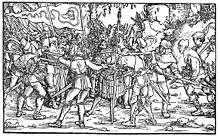Bundschuh movement

The Bundschuh movement (1493–1517) was a loosely linked series of localized peasant rebellions in southwestern Germany. It played an important part in the German Peasants' War of the early 15th and 16th centuries. It was so called because of the peasant shoe (Bundschuh = tied shoe) the peasants displayed on their flag – symbolizing the rising and advance of the peasants. Under this flag, peasants and city dwellers had defeated the troops of the French count of Armagnac along the upper Rhine in 1439, 1443 and 1444.
Individual uprisings – seeking relief from oppressive taxes, arbitrary justice systems, high debts, costly ecclesiastic privileges, serfdom, prohibitions on hunting and fishing, and the like – occurred in 1476 in Niklashausen (Tauber valley), 1493 in Sélestat/Alsace (for the first time under the Bundschuh banner), 1502 in Bruchsal and Untergrombach, 1513 in Lehen (Breisgau), and 1517 along the upper Rhine. Each of these was defeated very quickly, and the leaders were generally executed.
References
| Wikisource has original text related to this article: |
- Thomas Adam: Joß Fritz – das verborgene Feuer der Revolution. Bundschuhbewegung und Bauernkrieg am Oberrhein im frühen 16. Jahrhundert. Verlag Regionalkultur, Ubstadt-Weiher 2002, ISBN
3-89735-192-7 (Veröffentlichungen der Historischen Kommission der Stadt Bruchsal. Band 20)
- Friedrich Engels: Der deutsche Bauernkrieg. 15. Auflage. Dietz, Berlin 1987, ISBN 3-320-00291-0
- Albert Rosenkranz: Der Bundschuh. Die Erhebungen des südwestdeutschen Bauernstandes in den Jahren 1493–1517. Winter, Heidelberg 1927 (Schriften des wissenschaftlichen Instituts der Elsaß-Lothringer im Reich)
- Wilhelm Zimmermann: Allgemeine Geschichte des großen Bauernkrieges. 3 Bände, Stuttgart 1841-1843; 2. Auflage in 2 Bänden unter dem Titel Geschichte des großen Bauernkrieges, Stuttgart 1856; viele weitere Ausgaben
- Allgemeine Geschichte des grossen Bauernkrieges Erster Theil, Von Wilhelm Zimmermann, Stuttgart, Franz Heinrich Köhler, 1841
- Allgemeine Geschichte des grossen Bauernkrieges Zweiter Theil, Von Wilhelm Zimmermann, Stuttgart, Franz Heinrich Köhler, 1842
- Geschichte des grossen Bauernkriegs 1. Band: Nach den Urkunden und Augenzeugen Von Wilhelm Zimmermann, Veröffentlicht von Rieger'sche Verlagsbuchhandlung (A. Benedict), 1856
- Geschichte des grossen Bauernkriegs 2. Band: Nach den Urkunden und Augenzeugen Von Wilhelm Zimmermann, Veröffentlicht von Rieger'sche Verlagsbuchhandlung (A. Benedict), 1856:)